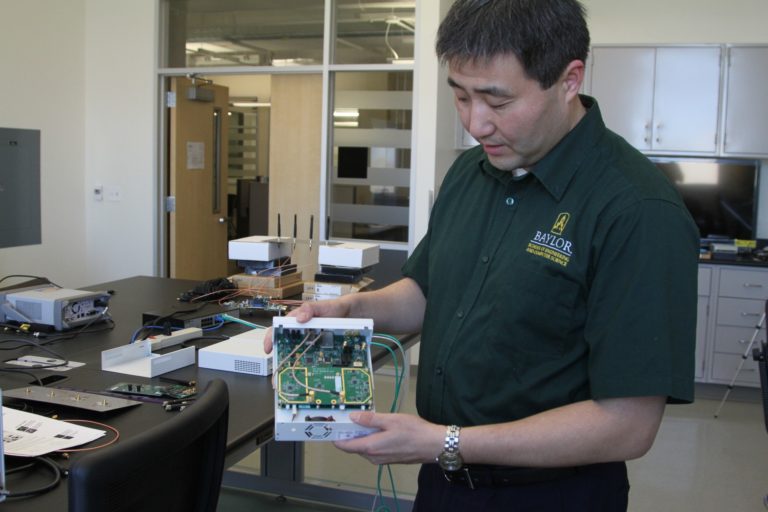
Dr. Liang (Leon) Dong is an Associate Professor in the Department of Electrical and Computer Engineering at Baylor University. His research focuses on signal processing and communications, wireless communications and networking, cyber-physical systems and security, and artificial intelligence and machine learning with biomedical applications. His research has received funding from the National Science Foundation (NSF), National Cancer Institute (NCI) of the National Institutes of Health (NIH), multiple branches of the Department of Defense (DoD) including the Army, DEVCOM Army Research Laboratory (ARL), and TARDEC, the National Aeronautics and Space Administration (NASA), as well as industry leaders such as L3Harris, Intel, ExxonMobil, and Denso. Dr. Dong is a Senior Member of the Institute of Electrical and Electronics Engineers (IEEE) and a Member of the American Physical Society (APS).
Education
- Post-Doctoral, Electrical Engineering, University of Notre Dame (2002-2004)
- Ph.D., Electrical and Computer Engineering, University of Texas at Austin (2002)
- M.S., Electrical and Computer Engineering, University of Texas at Austin (1998)
- B.S., Applied Physics, Computer Engineering, Shanghai Jiao Tong University (1996)
Current Research Projects
 AI-Driven Predictive Analytics and Interference Mitigation for Enhanced Wireless Communication Systems
AI-Driven Predictive Analytics and Interference Mitigation for Enhanced Wireless Communication Systems
Spectrum Management with Adaptive and Reconfigurable Technologies (SMART) Hub
Project Goal: This project aims to advance wireless communication systems through two complementary approaches: (1) implementing AI transformer models for predictive analytics in spatial, spectral, and temporal dimensions to enhance channel state information prediction, optimize spectrum utilization, and forecast network traffic; and (2) developing an AI-driven framework using attention-based transformer models for real-time radio frequency interference (RFI) detection and mitigation in communication receivers. By integrating these transformative AI solutions into existing network infrastructures, the project will deliver more efficient resource allocation, improved signal quality, enhanced user mobility management, and robust interference cancellation capabilities, ultimately resulting in superior wireless communication performance across diverse operational environments.
 Fused Unified Sensor Imaging and Optimization Network
Fused Unified Sensor Imaging and Optimization Network
Project Goal: The FUSION (Fused Unified Sensor Imaging and Optimization Network) project aims to develop advanced image processing techniques for uncooled thermal long-wavelength infrared (LWIR) cameras to enhance imagery available to soldiers in field operations. By creating a comprehensive suite of software modules, FUSION will address key limitations of uncooled LWIR cameras through non-uniformity correction, noise reduction, frame-to-frame stabilization, and ego motion deblurring. The system will implement real-time sensor fusion of LWIR and visible/near-infrared imagery using AI/ML algorithms, incorporate adaptive image enhancement, develop a closed-loop system for optimizing camera parameters across various operational conditions, and design a distributed aperture system for multi-sensor integration. These advancements will provide soldiers with clearer, more detailed thermal imagery and improved situational awareness across diverse battlefield environments.

Spectrum Management with Adaptive and Reconfigurable Technologies (SMART) Hub
Project Goal: This project aims to advance wireless communication systems through two complementary approaches: (1) implementing AI transformer models for predictive analytics in spatial, spectral, and temporal dimensions to enhance channel state information prediction, optimize spectrum utilization, and forecast network traffic; and (2) developing an AI-driven framework using attention-based transformer models for real-time radio frequency interference (RFI) detection and mitigation in communication receivers. By integrating these transformative AI solutions into existing network infrastructures, the project will deliver more efficient resource allocation, improved signal quality, enhanced user mobility management, and robust interference cancellation capabilities, ultimately resulting in superior wireless communication performance across diverse operational environments.

Project Goal: The FUSION (Fused Unified Sensor Imaging and Optimization Network) project aims to develop advanced image processing techniques for uncooled thermal long-wavelength infrared (LWIR) cameras to enhance imagery available to soldiers in field operations. By creating a comprehensive suite of software modules, FUSION will address key limitations of uncooled LWIR cameras through non-uniformity correction, noise reduction, frame-to-frame stabilization, and ego motion deblurring. The system will implement real-time sensor fusion of LWIR and visible/near-infrared imagery using AI/ML algorithms, incorporate adaptive image enhancement, develop a closed-loop system for optimizing camera parameters across various operational conditions, and design a distributed aperture system for multi-sensor integration. These advancements will provide soldiers with clearer, more detailed thermal imagery and improved situational awareness across diverse battlefield environments.

Project Goal: This project aims to accelerate the development of highly specific targeted cancer therapeutics by integrating advanced artificial intelligence methodologies with rigorous experimental validation. Our innovative platform combines graph-string transformers and reinforcement learning algorithms to efficiently navigate vast chemical spaces, generating novel bispecific molecules with dual-targeting capabilities. These AI-designed compounds simultaneously target critical paired enzyme systems--either NK1R/NET in neuroblastoma or SCD-1/FADS2 in cancer metabolism--to overcome therapy resistance mechanisms. By strategically exploiting synergistic regulatory relationships between these paired targets, our approach addresses the compensatory mechanisms that typically enable cancer cells to evade single-target therapies. The computational framework prioritizes molecules with superior binding affinity, optimal physicochemical properties, and improved in vivo kinetics, while incorporating explainable AI methods to enhance result interpretability, potentially revolutionizing precision medicine approaches in oncology.

|

|

Baylor Lariat, March 2018 Deep learning, artificial intelligence leading the way to smart houses |
|
Youtube, December 2018 |
Youtube, December 2018 |

Baylor Magazine, February 2015 High-flying Wi-Fi |
E-BEARS Seminar
- March 1, 2024"Artificial Intelligence in Image and Video Analysis", Dr. Scott Acton, University of Virginia
- April 11, 2024"Clinical Molecular Imaging - An Overview of the Current State and Opportunities for Collaborations to Make it Better", Dr. Orhan Öz, The University of Texas Southwester Medical Center
- April 16, 2024"Molecular Design of Diagnostic Agents and the Potential Role of Artificial Intelligence", Dr. Xiankai Sun, The University of Texas Southwester Medical Center
Teaching
- ELC 4351Digital Signal Processing (2018-Present, Fall 2017, Spring 2017, Fall 2016)
- [IEEE Signal Processing Magazine] [IEEE Signal Processing Magazine]
- ELC 5396Introduction to Deep Learning (2018-Present)
- ELC 4350Principles of Communication (2011-2016, 2020-Present)
- ELC 5396Wireless Communication and Networking (Fall 2017)
- ELC 5356Statistical & Adaptive Signal Processing (Spring 2017)
- ELC 5396Digital Communications (Fall 2016)
- ELC 4438Embedded Systems Design (Spring 2016)
Research Interests

Signal Processing and Communications
Our research in signal processing and communications focuses on developing advanced algorithms for efficient information extraction, transmission, and analysis. We investigate novel techniques for signal detection, estimation, and enhancement in complex environments with particular emphasis on statistical and adaptive methods. These approaches enable robust communication systems capable of operating under challenging conditions, including low signal-to-noise ratios, multipath fading, and interference. Applications range from next-generation wireless networks to biomedical signal analysis, with the overarching goal of improving reliability, efficiency, and performance across diverse technological domains.

Wireless Communications and Networking
The wireless communications and networking research in our lab addresses fundamental challenges in spectrum utilization, network optimization, and quality of service for next-generation communication systems. We develop innovative solutions for dynamic spectrum access, interference mitigation, and resource allocation to maximize system capacity and energy efficiency. Our work spans multiple network layers, from physical layer waveform design to network routing protocols and cross-layer optimization frameworks. Current projects include MIMO systems, cognitive radio networks, millimeter-wave communications, and adaptive protocols for heterogeneous networks--all contributing to the advancement of infrastructure that enables ubiquitous connectivity in our increasingly digital society.

Cyber-Physical System and Security
Our cyber-physical systems research investigates the integration of computational algorithms with physical processes in applications ranging from smart infrastructure to autonomous transportation. We examine security vulnerabilities in these interconnected systems and develop countermeasures against sophisticated cyber threats. Our approach encompasses secure system design, anomaly detection, intrusion prevention, and resilient control strategies. We pay particular attention to protecting critical infrastructure against attacks that could compromise both digital components and physical operations. By addressing security challenges at the cyber-physical interface, our research helps create more trustworthy, reliable, and resilient systems that can withstand evolving threat landscapes while maintaining essential functionality.

Artificial Intelligence/Machine Learning with Biomedical Applications
We leverage artificial intelligence and machine learning techniques to transform biomedical research and healthcare delivery. Our interdisciplinary approach combines signal processing expertise with deep learning architectures to analyze complex biomedical data, including medical images, physiological signals, and molecular information. Current projects include developing advanced neural networks for disease classification, predictive analytics for personalized medicine, and automated diagnostic systems. We place special emphasis on creating explainable AI models that provide interpretable results for clinical decision support. Through collaborations with medical researchers and healthcare providers, we translate computational advances into practical tools that improve patient outcomes and enhance understanding of biological systems.

Edge AI and Hardware Acceleration
Our research in Edge AI and hardware acceleration focuses on bringing artificial intelligence capabilities to resource-constrained devices at the network edge. We develop efficient algorithms and implementation strategies for deploying neural networks on embedded systems, IoT devices, and specialized hardware accelerators. By optimizing model compression, quantization, and hardware-aware neural architecture design, we enable real-time inference with minimal energy consumption. Current work includes FPGA-based implementations of convolutional neural networks, ultra-low-power AI for sensor networks, and custom hardware architectures for specific applications. This research enables distributed intelligence in environments where cloud connectivity is limited, latency requirements are strict, or privacy concerns necessitate local processing.
© Liang (Leon) Dong, 2025

